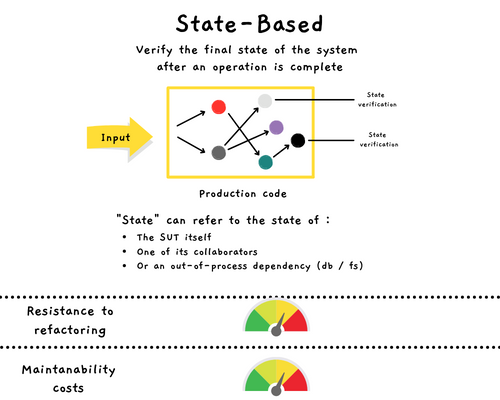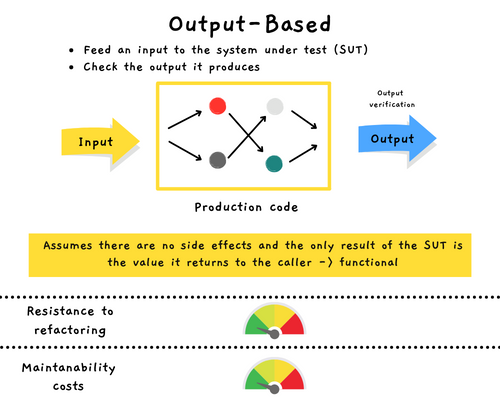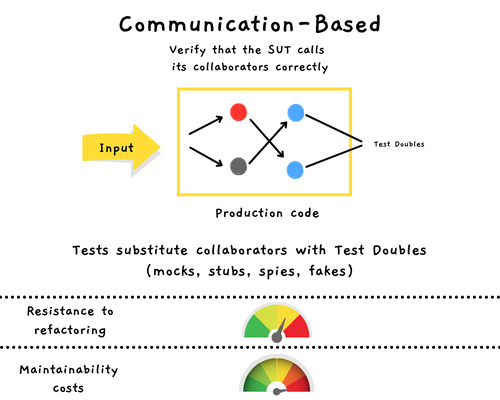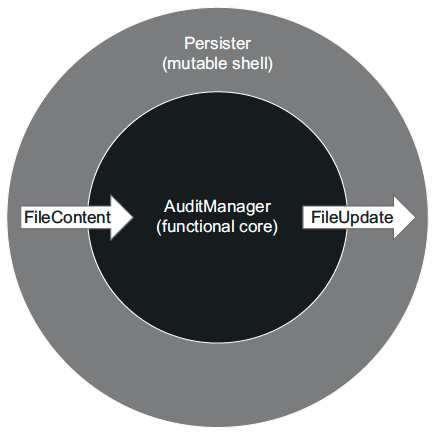Styles of Unit Tests
Learning Objectives
- Understand the 3 types of Unit Tests
- Have in mind the drawbacks of the different styles and how/why to migrate from one to another
Session Outline
- 5 min connect: Audit review
- 10 min concept: Styles and costs
- 40 min concrete: Refactor to output-based testing
- 5 min conclusions: Test readability
Connect - Audit review
Open the AuditManager_Should test class from the Audit kata - the code is in the Audit-Kata repo.
- What can be improved in the tests? Why?
- What make this test hard to understand / maintain?
- What do you think about the naming?
Concepts - Styles and costs

State-Based Example
[Fact]
public void It_Should_Add_Given_Product_To_The_Order()
{
var product = new Product("Free Guy");
var sut = new Order();
sut.Add(product);
sut.Products.Should()
.HaveCount(1)
.And.Satisfy(item => item.Equals(product));
}

Output-Based Example
[Fact]
public void Discount_Of_2_Products_Should_Be_2_Percent()
{
var product1 = new Product("Kaamelott");
var product2 = new Product("Free Guy");
var discount = PriceEngine.CalculateDiscount(product1, product2);
discount.Should().Be(0.02);
}

Refactorings are harder with Communication-based : if you change the interaction you need to change the tests as well.
Communication-Based Example
[Fact]
public void Greet_A_User_Should_Send_An_Email_To_It()
{
const string email = "john.doe@email.com";
var emailGatewayMock = new Mock<IEmailGateway>();
var sut = new Controller(emailGatewayMock.Object);
sut.GreetUser(email);
emailGatewayMock.Verify(e => e.SendGreetingsEmail(email), Times.Once);
}
The images above are part of the Unit Testing Principles, Practices and Patterns book infographic available here.
Concrete Practice - Refactor to output-based testing
Explain the purpose of the Audit kata.
Ask them to:
- Refactor the tests and production code to
Output basedtests- Instead of hiding side effects behind an interface and injecting that interface into AuditManager, we can move those side effects out of the class entirely :
AuditManageris then only responsible for making a decision about what to do with the files- A new class,
Persisteracts on that decision and applies updates to the filesystem
- Instead of hiding side effects behind an interface and injecting that interface into AuditManager, we can move those side effects out of the class entirely :

A step-by-step guide is available here.
Conclusion
Compare the first version of the unit test with the new one.
Which one is the easiest to read and why ?
Resources
Concepts are coming from Vladimir Khorikov’s book : Unit Testing Principles, Practices and Patterns.